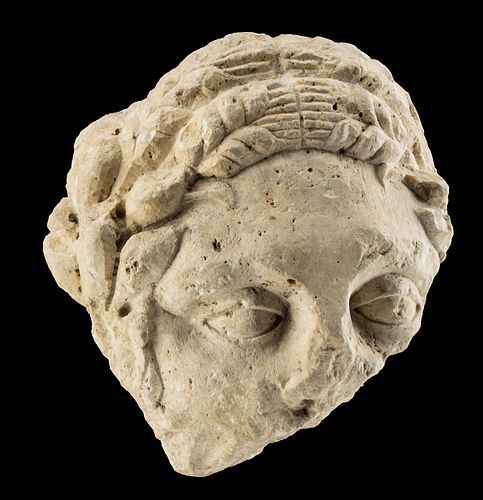Lifesize Roman Limestone Relief Head of Female
Lot 41b
About Seller
Artemis Fine Arts
686 S Taylor Ave, Ste 106
Louisville, CO 80027
United States
Selling antiquities, ancient and ethnographic art online since 1993, Artemis Gallery specializes in Classical Antiquities (Egyptian, Greek, Roman, Near Eastern), Asian, Pre-Columbian, African / Tribal / Oceanographic art. Our extensive inventory includes pottery, stone, metal, wood, glass and textil...Read more
Categories
Estimate:
$3,200 - $4,800
Absentee vs Live bid
Two ways to bid:
- Leave a max absentee bid and the platform will bid on your behalf up to your maximum bid during the live auction.
- Bid live during the auction and your bids will be submitted real-time to the auctioneer.
Bid Increments
| Price | Bid Increment |
|---|---|
| $0 | $25 |
| $300 | $50 |
| $1,000 | $100 |
| $2,000 | $250 |
| $5,000 | $500 |
| $10,000 | $1,000 |
| $20,000 | $2,500 |
| $50,000 | $5,000 |
| $100,000 | $10,000 |
| $200,000 | $20,000 |
About Auction
By Artemis Fine Arts
Mar 24, 2022
Set Reminder
2022-03-24 10:00:00
2022-03-24 10:00:00
America/New_York
Bidsquare
Bidsquare : Exceptional Antiquities Ethnographic Fine Art
https://www.bidsquare.com/auctions/artemis-gallery/exceptional-antiquities-ethnographic-fine-art-9057
Museum-worthy examples of classical antiquities (Egyptian, Greek, Roman, Near Eastern), Viking, Far East / Asian, Pre-Columbian, African / Tribal, Oceanic, Native American, Spanish Colonial, Fossils, Ancient Jewelry, Fine / Visual Arts, so much more! Artemis Fine Arts info@artemisgallery.com
Museum-worthy examples of classical antiquities (Egyptian, Greek, Roman, Near Eastern), Viking, Far East / Asian, Pre-Columbian, African / Tribal, Oceanic, Native American, Spanish Colonial, Fossils, Ancient Jewelry, Fine / Visual Arts, so much more! Artemis Fine Arts info@artemisgallery.com
- Lot Description
Roman, Imperial Period, ca. 1st to 3rd century CE. A beautiful life-sized fragment of a woman's head, perhaps a female fertility or vegetation personification such as Ceres (Greek Demeter) or Tellus (also Terra Mater, "Mother Earth"). Skillfully hand-carved from mottled honey-yellow marble with gray, light beige, and slate-hued inclusions, the enigmatic visage presents with a pair of heavy lidded, almond-shaped eyes beneath gently sweeping brows, a broad nose with 1 visible nostril, indented interior and elongated exterior canthi, and a slightly rounded cheek. Her high forehead is surmounted by a double wreath comprised of corn stalks, thick leaves, and/or other fruit and foliage. The sculptural fragment is mounted on a modern lucite block for display purposes. Size (face): 8.8" W x 9.1" H (22.4 cm x 23.1 cm); (display block): 12.6" W x 14.5" H (32 cm x 36.8 cm)
Ceres was the goddess of the harvest who was believed to watch over the earth's fertility, the law of the land, as well as the cycle of life and death itself. In addition, Ceres (Greek Demeter) along with her daughter Proserpina (Greek Persephone) were central figures in the Eleusinian mysteries. These were elaborate festivals that took place every five years. Unfortunately, scholars know little about them as those who attended the Eleusinian Mysteries were sworn to secrecy. This said, most agree that the central theme of these Mysteries was that just as the grain returns every spring following its harvest and the winter hibernation period, the soul returns after the death of the human body, reincarnated for the next life. The Eleusinian Mysteries were not the only Mysteries of the Greco-Roman world. There were also the Mysteries of Dionysos depicted in a famous fresco just outside Pompeii at Herculaneum (the so-called Villa of the Mysteries) as well as Mysteries of various imported eastern gods such as Sabazios and Isis.
Cf. The Metropolitan Museum of Art, accession number 27.122.1
Provenance: private New York, New York, USA collection; ex-private F.M. collection, South Germany, acquired 1975 to 1990
All items legal to buy/sell under U.S. Statute covering cultural patrimony Code 2600, CHAPTER 14, and are guaranteed to be as described or your money back.
A Certificate of Authenticity will accompany all winning bids.
PLEASE NOTE: Due to recent increases of shipments being seized by Australian & German customs (even for items with pre-UNESCO provenance), we will no longer ship most antiquities and ancient Chinese art to Australia & Germany. For categories of items that are acceptable to ship to Australia or Germany, please contact us directly or work with your local customs brokerage firm.
Display stands not described as included/custom in the item description are for photography purposes only and will not be included with the item upon shipping.
#170859This is a fragment of a larger sculpture with losses to peripheries, verso, and head and body below nose and upper portion of proper right cheek as shown. Nicks, chips, pitting, and abrasions to nose, eyes, brow, coiffure, peripheries, and verso, with softening to some finer details, and light encrustations. Great surface smoothness and preservation of overall form. Drilled in 2 areas through verso with adhesive along rims of drill holes for attachment to lucite block as well as for mounting purposes.Condition
- Shipping Info
-
All shipping is handled in-house for your convenience. Your invoice from Artemis Gallery will include shipping calculation instructions. If in doubt, please inquire BEFORE bidding for estimated shipping costs for individual items.
-
- Buyer's Premium



 EUR
EUR CAD
CAD AUD
AUD GBP
GBP MXN
MXN HKD
HKD CNY
CNY MYR
MYR SEK
SEK SGD
SGD CHF
CHF THB
THB














